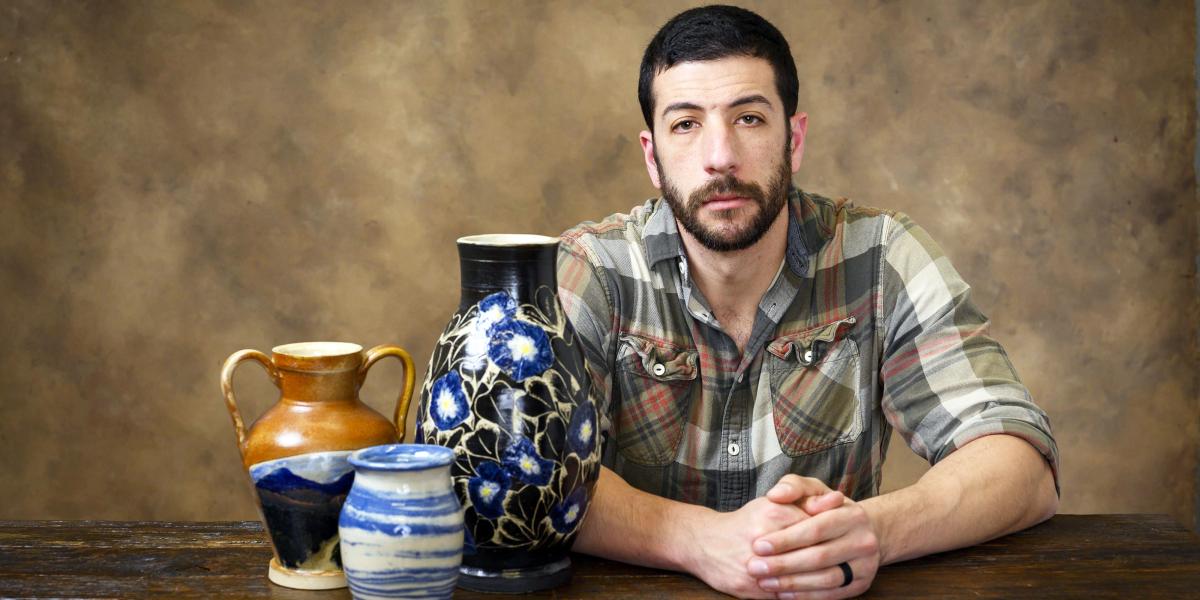Pottery and Purpose
The ancient craft helps an Army veteran find peace and healing.
The first time I sat down at a pottery wheel my life changed.
Two years ago, after a decade in the Army that included three deployments to Afghanistan and Syria, I was facing the long-term health impacts of military service. Head injuries from parachute jumps and an improvised explosive device blast left me with a host of neurological and vestibulocochlear deficits. Despite treatment, the migraines, difficulties with balance, and constant nausea persisted.
I was also facing challenges in making the transition back to a life at home.
When I went into the Army, I was a young man who loved to work out and backpack in the woods. Over the next 10 years, working out became something else entirely: I did it because I was afraid that I wouldn’t be strong enough to carry my friends to safety. And years of forced ruck marches had drained the enjoyment out of hiking.
Living in North Carolina after my last deployment, I had no hobbies or interests unrelated to my military life. I also had to grapple with not being physically capable of doing things that I once loved. I felt adrift and without purpose. Many who leave the military experience the same feelings. Military life is a constant barrage of purpose. Every action is nested within a commander's intent, which is in turn nested within a higher commander's intent, and so on. Purpose—even if the purpose doesn't make sense—and your identity as a soldier dominate every aspect of your life: interactions with family, your sleep, your exercise.
Looking for an activity that we could do together, my wife signed us both up for a pottery class at the local community college. I immediately took to wheel throwing: the persistent attention to spin and balance, the continuum between friction and mobility, and between earth and water.
I fell in love with the idea of creating millennia-old forms of craft and industry with simple tools and my own hands. I started making bowls and mugs, but I rapidly became enthralled with making Greek amphora and vase forms from antiquity.
Pottery making proved to be therapeutic. When production and creation were measured in weeks and months, the slow, deliberate drying cycles gave my life a sense of structure and a schedule of sorts. The attention to balance, not in a clinical rehabilitation setting, but between my hands and a ball of earth, reduced my nausea and vertigo. For the first time, the debilitating headaches that dogged me for years started to diminish.
I fell in love with the idea of creating millennia-old forms of craft and industry with simple tools and my own hands.
Medical interventions are essential in treating post-traumatic stress or brain injuries and the complex mix of burn-out, lack of purpose, and physical and moral injury that accompany so many veterans’ return home from war. Neurological care can address some of the post-traumatic migraines. Ophthalmology and audiology can address post-concussive changes in vision and hearing loss. Physical therapy offers partial solutions for problems with balance, coordination, and nausea associated with inner ear trauma. However, all of these advanced specialties fall short in treating the whole person.
Pottery making helped fill that gap. I came to view this ancient art as healing. That realization clarified the importance of wellness practices and self-care as part of my recovery from physical and psychological wounds.
Making pottery also brought to mind The Iliad, which contains the earliest mention of wheel-thrown pottery in Western literature. It tells the story of Achilles, a young man whose life was defined by a decade at war, the injustice of combat, and grief over the death of his friend and lover. The epic poem evokes the timeless truth that life continues far-removed from the carnage of war. Depicting a city at war, and one at peace, the story paints a picture of young people dancing at a wedding “like the motion a potter gives his wheel.”
With this image, Homer captures the union of industry and vitality as quintessential to the human experience.
Over the past two years, I have continued making pottery as I transitioned out of the military and back to school. The craft has come to represent a dividing line in my life between war and finding an inward-facing peace. For me, turning to the arts provided a way to heal, and I hope that by telling this story I can help others find a way to rebuild their purpose after war.
